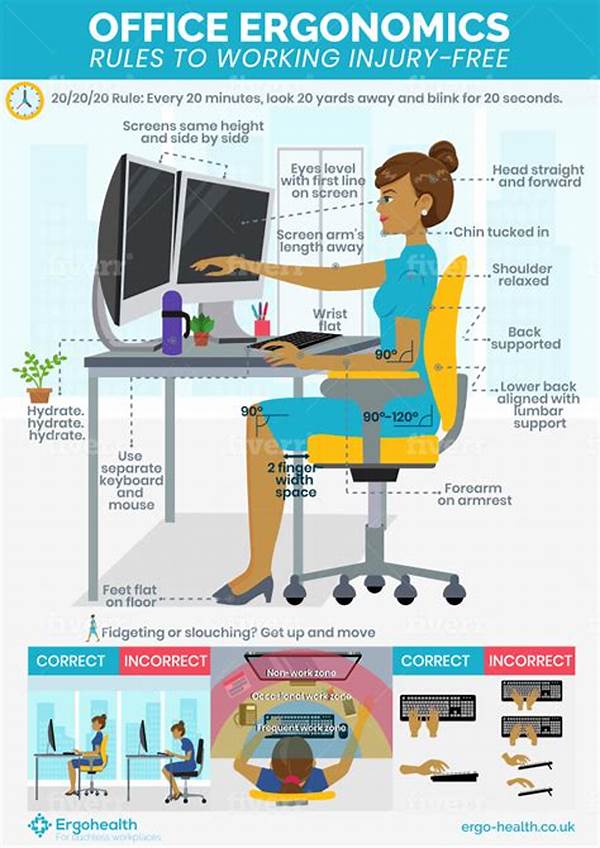In the contemporary academic landscape, the importance of a well-configured study environment cannot be overstated. For students engaging in prolonged periods of study, maintaining both physical health and focus is imperative. A posture-friendly study environment serves as the foundational framework for achieving this balance. The insights provided herein aim to guide individuals in creating a conducive atmosphere that not only promotes effective study habits but also mitigates the potential for physical strain and discomfort typically associated with extended study sessions.
Read Now : “creating Engaging Brand Stories”
The Essence of a Posture-Friendly Study Environment
Central to the concept of a posture-friendly study environment is the integration of ergonomic principles that prioritize the physical well-being of the student. Ergonomics — the study of people’s efficiency in their working environment — provides invaluable guidance in designing a space that nurtures both comfort and productivity. By considering factors such as chair height, desk position, and the alignment of computer screens, individuals can significantly reduce the risk of musculoskeletal ailments. Furthermore, a study environment that embraces these considerations invariably enhances cognitive function, thus leading to improved learning outcomes. These posture-friendly study environment tips are pivotal in fostering not only academic excellence but also overall health and wellness among students.
Key Posture-Friendly Study Environment Practices
1. Ergonomic Chairs: Utilizing chairs that offer lumbar support is crucial. The curvature of the lower back must be supported to maintain proper spinal alignment.
2. Proper Desk Height: A desk should be at elbow height, allowing the forearms to rest parallel to the ground. This mitigates shoulder and neck strain.
3. Computer Monitor Placement: The top of the monitor should be at or slightly below eye level to prevent neck strain associated with tilting one’s head.
4. Adequate Lighting: Proper lighting reduces eye strain. A combination of natural and artificial light is ideal, with the light source positioned to prevent glare on screens.
5. Regular Breaks: Incorporating short, regular intervals of movement and stretching is essential. This breaks the monotony of sitting and reduces accumulated tension.
Designing the Optimal Study Environment
A posture-friendly study environment is characterized by its capacity to adapt to the individual needs of the student. When designing this space, it is essential to consider both physical and psychological factors. From a physical standpoint, ergonomic furniture plays a vital role. Seats with adequate back support, desks of adjustable height, and monitors positioned at eye level are necessary to prevent long-term physical complications. Psychologically, the study environment must minimize distractions to promote focus. Here, the arrangement of space and the incorporation of plants or artwork can positively influence mood and concentration.
Additionally, maintaining the tidiness of a study space is intrinsically linked to cognitive clarity. A clutter-free environment enhances the mind’s ability to process information efficiently. Thus, one of the crucial posture-friendly study environment tips is to routinely organize and declutter. These strategies work synergistically to cultivate an environment where students can thrive both academically and personally.
Read Now : Technology-driven Math Adaptations
Implementing Effective Study Habits
Understanding posture-friendly study environment tips is only half the equation; implementing them is where the true benefit lies. Effective study habits begin with the thoughtful arrangement of one’s study space. Investing in ergonomic tools and technology designed to accommodate prolonged use is vital. Furthermore, personalizing the environment can motivate and inspire, creating an inviting space that one is eager to return to. Regular evaluations of the environment ensure it continues to meet evolving ergonomic needs.
Maintaining a posture-friendly study environment involves continuous education and adaptation. As technological advancements introduce new modalities of learning, staying informed about ergonomic best practices allows students to adjust dynamically. Indeed, success in academics is closely intertwined with maintaining optimal health, and these posture-friendly study environment tips serve as a blueprint for achieving this equilibrium.
Practical Considerations and Adjustments
Creating a truly posture-friendly study environment requires more than just a one-time setup. Continuous assessment and adjustments are necessary to ensure the environment remains conducive to healthy study habits. Ergonomic advancements and innovative technology solutions can support these adaptations, ensuring that the discomfort often linked with extended academic pursuits is minimized. Personalized choices, like chair type and desk organization, should evolve as students’ preferences and academic needs change over time.
Understanding the importance of sensory elements, such as appropriate lighting and color schemes, is equally vital. For instance, softer colors may promote relaxation, aiding in concentration. Students should also not overlook the psychological impact of their study surroundings; an aesthetically pleasing environment can boost motivation and willingness to study. Incorporating these posture-friendly study environment tips can profoundly affect one’s study efficiency and well-being.
Conclusion: The Ongoing Journey of Improvement
In conclusion, fostering a posture-friendly study environment is a continuous process that necessitates regular reflection and adjustment. Such an environment is not merely about physical arrangements but encompasses psychological and sensory elements as well. The suite of posture-friendly study environment tips provided herein equips individuals with the tools to cultivate a space that supports their academic and health goals comprehensively.
Moreover, as educational demands and technological interfaces evolve, so too must the environments in which students engage. Proactively adapting to these developments ensures that the study space remains a place of productivity and comfort. Ultimately, the pursuit of a posture-friendly study environment contributes significantly to sustainable academic success and well-being, highlighting the inherent synergy between ergonomic awareness and educational achievement.
